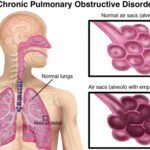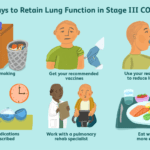
In this informative article, we will explore how to determine what stage of COPD you are in. COPD, short for Chronic Obstructive Pulmonary Disease, is a progressive lung condition that can have varying degrees of severity. Identifying your stage of COPD is crucial for both understanding your current level of lung function and guiding your treatment plan. By recognizing the signs and symptoms associated with each stage, you can gain valuable insights into managing COPD and maintaining a high quality of life.
Symptoms and Physical Examination
Symptoms of COPD
When it comes to determining the stage of your COPD, it is important to pay attention to the symptoms you are experiencing. While symptoms can vary from person to person, there are some common signs of COPD that you should be aware of. These symptoms include persistent coughing that produces mucus, shortness of breath, wheezing, chest tightness, fatigue, and frequent respiratory infections. If you have been experiencing any of these symptoms, it is important to consult with a healthcare professional for a proper diagnosis.
Physical Examination
In addition to paying attention to your symptoms, a physical examination can also help determine the stage of your COPD. During a physical examination, your healthcare professional may listen to your lungs with a stethoscope and look for signs of chest wall abnormalities. They may also assess your breathing patterns and determine the amount of airflow limitation you are experiencing. By conducting a physical examination, your healthcare professional can gather important information that will assist in determining the severity of your condition.
Medical Assessment
Pulmonary Function Tests
Pulmonary function tests (PFTs) are essential in diagnosing and assessing the severity of COPD. These tests measure how well your lungs are functioning by evaluating various parameters, including lung capacity, airflow, and oxygen exchange. The most common type of PFT used in COPD assessment is spirometry, which measures the amount and speed of air you can inhale and exhale. This test can provide valuable information on the airflow limitation you are experiencing, and it helps determine the stage of COPD.
Arterial Blood Gas Analysis
Arterial blood gas (ABG) analysis is another essential component of the medical assessment for COPD. This test involves taking a sample of blood from an artery, typically the radial artery in your wrist, and analyzing the levels of oxygen, carbon dioxide, and other gases in your blood. ABG analysis helps assess the extent of respiratory impairment and can help guide the appropriate treatment for your COPD.
Chest X-ray or CT scan
Imaging tests, such as chest X-rays or CT scans, may also be conducted as part of the medical assessment for COPD. These tests can help identify physical changes in your lungs, such as emphysema or bronchial wall thickening, which are indicative of COPD. Additionally, they can help rule out other lung diseases that may present similar symptoms to COPD. By analyzing these images, your healthcare professional can gain a better understanding of the stage and severity of your COPD.
Blood Tests
Blood tests are often performed to assess the overall health and determine the impact of COPD on your body. These tests can measure various parameters, such as complete blood count, liver and kidney function, and levels of specific proteins and enzymes. By evaluating these results, your healthcare professional can identify any potential complications or comorbidities associated with COPD and tailor the treatment plan accordingly.

Stages of COPD
Stage 1 – Mild COPD
At the mild stage of COPD, you may experience mild airflow limitation in your lungs. This is characterized by a post-bronchodilator forced expiratory volume in one second (FEV1) of 80% or more of the predicted value. You may have a persistent cough with mucus production and occasional shortness of breath, particularly during physical activity. At this stage, COPD may not significantly impact your daily life, but it is crucial to receive appropriate treatment to prevent further progression of the disease.
Stage 2 – Moderate COPD
In moderate COPD, you will have a post-bronchodilator FEV1 between 50% and 79% of the predicted value. Symptoms will become more noticeable and interfere with your daily activities. You may experience increased shortness of breath, coughing with increased mucus production, and fatigue. It is essential to seek medical attention at this stage to receive appropriate treatment and management strategies.
Stage 3 – Severe COPD
Severe COPD is characterized by a post-bronchodilator FEV1 between 30% and 49% of the predicted value. Symptoms at this stage become significantly worse, and you may experience frequent exacerbations, or flare-ups, of your condition. Shortness of breath becomes more pronounced, and you may find it difficult to perform everyday tasks. It is crucial to receive comprehensive medical care, including pulmonary rehabilitation and specialized treatments, to manage your symptoms effectively.
Stage 4 – Very Severe COPD
At the very severe stage of COPD, your post-bronchodilator FEV1 falls below 30% of the predicted value or below 50% with chronic respiratory failure. Symptoms are extremely debilitating, and you may experience severe limitations in your daily activities. Shortness of breath is present even at rest, and exacerbations are frequent and severe. Medical intervention and advanced therapies, such as oxygen therapy or lung transplantation, are often necessary to manage the symptoms and improve your quality of life.
GOLD Classification
The Global Initiative for Chronic Obstructive Lung Disease (GOLD) provides a classification system for COPD based on the severity of airflow limitation. This classification system helps healthcare professionals assess the stage of COPD and determine appropriate treatment plans. The GOLD classification includes the following stages:
GOLD 1: Mild COPD
In the GOLD 1 stage, the FEV1 is equal to or greater than 80% of the predicted value. Symptoms are typically mild, with occasional cough and shortness of breath during physical activity. At this stage, pulmonary function tests may reveal mild obstruction.
GOLD 2: Moderate COPD
GOLD 2 is characterized by an FEV1 between 50% and 79% of the predicted value. Symptoms become more apparent and may include increased shortness of breath, coughing with mucus production, and fatigue.
GOLD 3: Severe COPD
In GOLD 3, the FEV1 falls between 30% and 49% of the predicted value. Symptoms worsen significantly, and shortness of breath becomes more pronounced, even during minimal physical exertion. Exacerbations are more frequent, and quality of life is adversely affected.
GOLD 4: Very Severe COPD
The most severe stage of COPD is GOLD 4, where the FEV1 drops below 30% of the predicted value or below 50% with chronic respiratory failure. Symptoms are extremely debilitating, and daily activities are severely limited. Exacerbations are frequent and severe, requiring advanced treatment strategies.

CAT assessment
The COPD Assessment Test (CAT) is a simple yet effective tool used to assess the impact of COPD on your daily life. It consists of a questionnaire with eight items that evaluate different aspects of your condition.
Cough
The CAT questionnaire includes questions to assess the frequency and severity of your cough. Coughing is a common symptom of COPD, and its impact on your daily life can provide valuable information to healthcare professionals.
Phlegm
Phlegm production is another common symptom of COPD. The CAT assessment asks about the frequency and severity of phlegm production, helping to evaluate the impact of this symptom on your overall well-being.
Chest tightness
Chest tightness or discomfort is often experienced by individuals with COPD. The CAT questionnaire evaluates the frequency and severity of chest tightness as one of the items to assess the overall impact of your condition.
Breathlessness
Shortness of breath, also known as breathlessness, is a hallmark symptom of COPD. The CAT assessment captures the frequency and severity of breathlessness, giving healthcare professionals insight into how it affects your daily life.
Activity limitation
COPD can significantly limit your ability to engage in daily activities. The CAT questionnaire includes items that evaluate the impact of your condition on your physical activities and how it affects your overall quality of life.
Energy levels
Fatigue and decreased energy levels are common in individuals with COPD. The CAT assessment helps determine the extent to which your energy levels are affected by your condition, allowing healthcare professionals to tailor treatment plans accordingly.
Sleep quality
COPD can also impact your sleep quality due to symptoms like coughing or breathlessness. The CAT questionnaire assesses the impact of your condition on your sleep, providing valuable information for healthcare professionals in managing your COPD effectively.
BODE Index
The BODE Index is a multidimensional tool used to assess the severity and prognosis of COPD. It takes into account various factors that can influence the overall impact and progression of the disease.
Body mass index (BMI)
BMI is one of the factors considered in the BODE Index. It helps assess the impact of COPD on your body weight and overall nutritional status. A lower BMI may indicate a higher risk and severity of COPD.
Airflow Obstruction
Airflow obstruction, as measured by the FEV1, is an important component of the BODE Index. The lower the FEV1, the more severe the airflow limitation and the higher the BODE score.
Dyspnea (shortness of breath)
Dyspnea, or shortness of breath, is a significant symptom of COPD. The BODE Index evaluates the severity of dyspnea based on the Modified Medical Research Council (mMRC) scale or the Baseline Dyspnea Index (BDI).
Exercise Capacity
The BODE Index also considers exercise capacity as an important factor. This is typically assessed using the 6-minute walk test, which measures how far you can walk in six minutes. A lower distance indicates more severe limitations and a higher BODE score.

MRC Dyspnea Scale
The MRC Dyspnea Scale is a simple, self-reported tool used to assess the severity of breathlessness experienced by individuals with COPD. The scale consists of five statements that describe different levels of breathlessness, ranging from none (MRC grade 0) to breathlessness even while at rest (MRC grade 4). By evaluating your self-perceived level of breathlessness, healthcare professionals can better understand the impact of COPD on your daily life and adjust treatment plans accordingly.
COPD Exacerbations
COPD exacerbations refer to episodes of increased respiratory symptoms and worsening of lung function. The frequency and severity of exacerbations can provide valuable information about the stage and progression of COPD.
Frequency and severity of exacerbations
If you experience frequent exacerbations, it may indicate a more severe stage of COPD. Healthcare professionals consider the number of exacerbations in a year and their impact on your daily life when determining the appropriate management plan for your COPD.
Quality of Life Assessment
Assessing the impact of COPD on your quality of life is crucial for developing an effective management plan. Two commonly used tools for this purpose are the St. George’s Respiratory Questionnaire (SGRQ) and the modified Medical Research Council (mMRC) scale.
SGRQ (St. George’s Respiratory Questionnaire)
The SGRQ is a comprehensive questionnaire that evaluates various aspects of your daily life affected by COPD. It covers topics such as symptoms, activity limitations, impact on social activities and psychological well-being, and overall quality of life. By completing the SGRQ, you provide valuable information that helps healthcare professionals tailor your treatment plan to improve your quality of life.
mMRC (modified Medical Research Council) scale
The mMRC scale is a simplified tool used to assess the impact of breathlessness on your daily activities. It consists of five statements that describe different levels of breathlessness, ranging from breathlessness only when performing strenuous activities (mMRC grade 0) to breathlessness during less demanding activities (mMRC grade 4). The mMRC scale helps healthcare professionals understand the limitations imposed by your breathlessness and adapt management plans accordingly.
Consulting a Healthcare Professional
When it comes to determining the stage of your COPD and developing an effective management plan, consulting a healthcare professional is crucial. They will guide you through the necessary steps to accurately assess your condition and provide the appropriate treatment.
Discussing symptoms and medical history
During your consultation, it is important to openly discuss your symptoms and medical history with your healthcare professional. This information will help them understand the severity of your condition and guide them in determining the appropriate diagnostic tests and evaluations.
Medical tests and evaluations
Based on your symptoms and medical history, your healthcare professional may order various tests and evaluations to assess the stage of your COPD. These may include pulmonary function tests, arterial blood gas analysis, imaging tests like X-rays or CT scans, and blood tests. These tests provide valuable insights into the severity of your condition and assist in formulating an effective management plan.
Interpreting the results
Your healthcare professional will interpret the results of the diagnostic tests and evaluations to determine the stage of your COPD accurately. They will discuss the findings with you, explaining the implications and impact on your daily life.
Formulating a COPD management plan
Once the stage of your COPD has been determined, your healthcare professional will work with you to develop a comprehensive management plan. This plan may include lifestyle modifications, medication regimen, pulmonary rehabilitation, and regular follow-up appointments. The goal is to improve your symptoms, slow the progression of the disease, and enhance your overall quality of life.
Remember, if you suspect you have COPD or are concerned about its progression, it is essential to consult with a healthcare professional for an accurate diagnosis and appropriate management. By working closely with your healthcare team, you can effectively manage your COPD and lead a fulfilling life.









